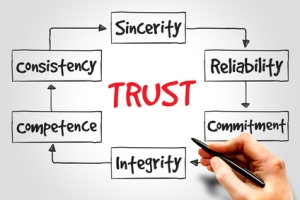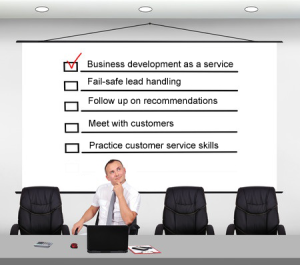 I was reminded this morning that it doesn’t take much for a service provider to stand out from the crowd. There is a lot of focus on enhancing the customer experience and creating strong relationships that clearly differentiate you from your competition. My experience with my mobile service provider was a perfect case in point.
I was reminded this morning that it doesn’t take much for a service provider to stand out from the crowd. There is a lot of focus on enhancing the customer experience and creating strong relationships that clearly differentiate you from your competition. My experience with my mobile service provider was a perfect case in point.
I woke up this morning to a problem. I could not send or receive emails from my smart phone. It seems that they were wiped out over the weekend when I was dealing with a completely unrelated problem. To set them up, I needed to know my user name and password. The ones I thought were correct turned out to be incorrect. Each time I tried it, the counter on my smartphone told me that I had only 6 tries left, then 5 tries, then 4.
On a normal day, this would be an inconvenience but this morning it was catastrophic (at least for me). It was 4:45 am and I was rushing to get to the airport for an early morning flight. We had a snowstorm overnight leaving the roads a mess and easily doubling the travel time. I would be away for a few days and my cell phone was my only link to my business during the day. I had to get this problem fixed quickly. I could feel the stress.
I called the carrier without much hope of getting anyone live at that time in the morning and, to my relief, I got through to a customer service representative. I explained the problem I was experiencing and he pointed out that I did not have an account and I would need to set one up. He explained how to go about it, gave me some helpful advice on selecting a User I.D., and waited on the phone while I completed the instructions. He then happily continued to stay on the line while I set up my emails, although he certainly did not have to. When I told him I appreciated his support he replied that he knew I was anxious about the situation and he wanted to ensure that everything went smoothly and should there be a glitch, he would be there to help me out.
Now, in the scheme of things, I guess you could say that the customer service representative was just doing his job. And maybe, he had nothing better to do at that time in the morning – I don’t suppose he would have been run off his feet. However, the willingness to stay on the line and guide me through the steps until everything was working the way I needed it was the best thing he could have done for me this morning. It showed that he was sensitive to my situation (please read this prior blog post on empathy) and he provided the level of support he felt would suit my needs in the circumstances.
It seems to me that this is something exceptional field service technicians do as a matter of course. They stay around a few extra minutes to ensure that the problem that was repaired was done so correctly. They follow-up on recent work to make certain the customer is happy. They understand and show empathy for the customer’s situation by acting in a way that best suits the customer’s needs given the circumstances. This isn’t much, but technicians who practice these small extra steps, certainly stand out from their peers. And, so do the companies they represent.
I’d love your feedback. And as always, please feel free to leave a link back to your own blog if you have one via the commentluv feature here on the site. If you are reading this blog post via email, you will need to locate this post on my website by clicking here. Scroll down to the bottom of the page where you will find the comment section.
Jim
“Service to others is the rent you pay for your room here on earth.”
– Muhammad Ali
 Many service managers I speak to see value in encouraging technicians to be more proactive in business development. Although many of those are taking steps to implement a formal plan for their service teams, many fail to achieve the results that they seek. If you want your technicians to be more proactive in promoting your services, check out your perspective. It might be getting in the way.
Many service managers I speak to see value in encouraging technicians to be more proactive in business development. Although many of those are taking steps to implement a formal plan for their service teams, many fail to achieve the results that they seek. If you want your technicians to be more proactive in promoting your services, check out your perspective. It might be getting in the way.
 In my last blog I talked about the
In my last blog I talked about the 
 If you are actively engaging your technicians in promoting your services, here are 5 questions to help you evaluate how proactive your service team is. These questions are part of our ‘How Proactive is Your Service Team’ Checklist.
If you are actively engaging your technicians in promoting your services, here are 5 questions to help you evaluate how proactive your service team is. These questions are part of our ‘How Proactive is Your Service Team’ Checklist.
 How is your business really doing was the subject of my
How is your business really doing was the subject of my  Whenever I speak on the subject of Proactive Service® , invariably someone will ask me how do we really know how we are doing? I mention that there are several measures to consider. Higher sales and revenues, increased customer satisfaction and improved levels of customer retention are just a few to consider. However, if you really want to know how you are doing, here are 2 questions to ask your customers through your surveys and during face-to-face visits:
Whenever I speak on the subject of Proactive Service® , invariably someone will ask me how do we really know how we are doing? I mention that there are several measures to consider. Higher sales and revenues, increased customer satisfaction and improved levels of customer retention are just a few to consider. However, if you really want to know how you are doing, here are 2 questions to ask your customers through your surveys and during face-to-face visits: In our programs, we dedicate a portion of our time to presenting an effective technique for taking the stress out of challenging situations. We discuss the impact of stress in emotional situations and the important role that we play as technicians to reduce it. The power of this technique was brought home to me last week.
In our programs, we dedicate a portion of our time to presenting an effective technique for taking the stress out of challenging situations. We discuss the impact of stress in emotional situations and the important role that we play as technicians to reduce it. The power of this technique was brought home to me last week. I was reminded this morning that it doesn’t take much for a service provider to stand out from the crowd. There is a lot of focus on enhancing the customer experience and creating strong relationships that clearly differentiate you from your competition. My experience with my mobile service provider was a perfect case in point.
I was reminded this morning that it doesn’t take much for a service provider to stand out from the crowd. There is a lot of focus on enhancing the customer experience and creating strong relationships that clearly differentiate you from your competition. My experience with my mobile service provider was a perfect case in point. “Money isn’t everything, … but it’s way ahead of whatever is in second place!” is a quote that is connected to some of the happiest times of my life. Little did I know at the time that, with a slight modification of a single word, it could hold an important message for service companies.
“Money isn’t everything, … but it’s way ahead of whatever is in second place!” is a quote that is connected to some of the happiest times of my life. Little did I know at the time that, with a slight modification of a single word, it could hold an important message for service companies.

